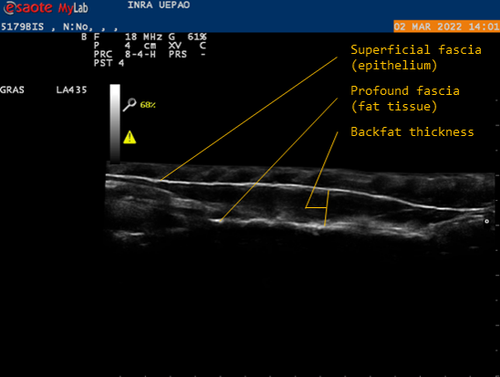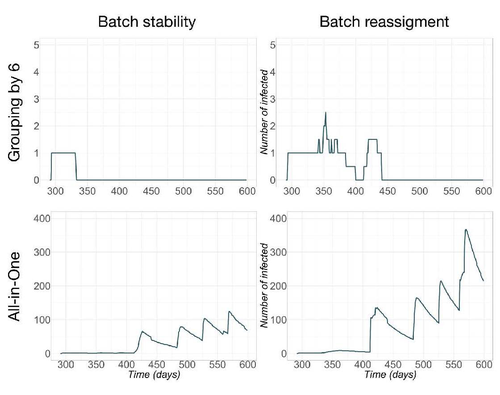Latest recommendations

| Id | Title | Authors▲ | Abstract | Picture | Thematic fields | Recommender | Reviewers | Submission date | |
|---|---|---|---|---|---|---|---|---|---|
11 Dec 2023

Genetic background of body reserves in laying hens through backfat thickness phenotypingNicolas Bédère, Joëlle Dupont, Yannick Baumard, Christophe Staub, David Gourichon, Frédéric Elleboudt, Pascale Le Roy, Tatiana Zerjal https://hal.inrae.fr/hal-04172576Towards a better optimization of the genetic improvement of chicken breeds: Introduction of simple phenotypic traits related to body composition for easy measurement in the selection programs of laying hens.Recommended by Seyed Abbas Rafat based on reviews by 2 anonymous reviewers based on reviews by 2 anonymous reviewers
In genetic selection, simplistic model of single-trait selection is usually considered, and the response to such approach is estimated using simple models. In practice, however, plant and animal breeders always deal with the selection of several traits, hence making the selection process very complex. Therefore, the simultaneous genetic improvement of several traits has always been one of the goals of livestock, including poultry breeding (Falconer, 1972). Studies that examine the indirect effects of selection on economic traits are eagerly awaited. In this context, the results of the study by Bédère et al., (2023) gives new insights about phenotypic and genotypic relationships between body reserves traits in laying hens. The authors aimed to propose novel data about the genetic architecture of traits related to body fat by measuring a series of phenotypic traits with relatively an easy approach. The authors further aimed to test and validate the phenotyping of backfat thickness as an indicator of the overall fatness of laying hens. Thus, the study allowed providing new evidence regarding the genetic determination of the backfat trait in chicken breeds. The authors first estimated the effect of selection on the residual feed intake (trait x) on the trait of body reserves (trait y). In fact, divergent selection experiments are a fundamental research tool that allow revealing significant amount of data related to the possible span of genetic improvement for traits of interest. Consequently, by analyzing data from a divergent selection experiment, associations have been estimated between a number of feed-dependent traits that have practical use for chicken breeders. Estimation of the correlations between traits is under question in terms of the theory of genetics and their application in multi-trait selection. As a major finding of the study, the observation of a bimodal distribution of backfat in both lines and the heterogeneity of the variances between families allowed suggesting a possible major gene, which could be investigated in future studies using for instance quantitative genetics. Body composition is continually studied in broilers chicken, but this aspect of chicken genetic is more detailed in laying hens. The current findings are worthy to validate using several approaches. In fact, one of the limitations of the study can be related to other statistical models that can be built. For example, the study revealed high correlations between egg production and body weight, thus body weight could be considered as a covariate in regression models. Moreover, the principal trait of selection (based on the residual feed intake) could be considered. References: Falconer, D. S. (1972). Introduction to Quantitative Genetics. Publisher: Ronald Press Company. pp 365. Bédère, N., Dupont, J., Baumard, Y., Staub, C., Gourichon, D., Elleboudt, F., Le Roy, P., Zerjal, T. (2023). Genetic background of body reserves in laying hens through backfat thickness phenotyping. HAL ver. 3 peer-reviewed and recommended by Peer Community in Animal Science. https://hal.inrae.fr/hal-04172576 | Genetic background of body reserves in laying hens through backfat thickness phenotyping | Nicolas Bédère, Joëlle Dupont, Yannick Baumard, Christophe Staub, David Gourichon, Frédéric Elleboudt, Pascale Le Roy, Tatiana Zerjal | <p>In this study, we pursued three primary objectives: firstly to test and validate the phenotyping of backfat thickness as an indicator of the overall fatness of laying hens; secondly, to estimate genetic parameters for this trait; thirdly, to st... |  | Animal genetics, Poultry, Statistical genetics | Seyed Abbas Rafat | 2023-07-27 17:09:10 | View | |
16 Apr 2021

Modelling the impact of the macroalgae Asparagopsis taxiformis on rumen microbial fermentation and methane productionRafael Muñoz-Tamayo , Juana C. Chagas, Mohammad Ramin, Sophie J. Krizsan https://doi.org/10.1101/2020.11.09.374330Understanding the mechanisms behind natural bioactive compounds that can potentially reduce methane production in anaerobic conditions. A case study of Asparagopsis taxiformisRecommended by Luis Tedeschi based on reviews by Alberto Atzori, Henk van Lingen and 2 anonymous reviewersNaturally occurring compounds that can reduce methane production in anaerobic conditions have been studied for quite some time as feasible approaches to mitigate methane production in ruminant animals, especially those of commercial importance. Asparagopsis taxiformis (red algae) and Dictyota bartayresii (brown algae) are effective inhibitors of methane synthesis under in vitro anaerobic fermentation systems (Machado et al., 2014) likely because of their high concentration of secondary metabolites that are toxic to the typical rumen microbiota, including protozoa. In addition to phytoplankton (Palmer and Reason, 2009), Asparagopsis contains a high concentration of haloform compounds (e.g., bromoform, chloroform) while Dictyota has a high concentration of isoprenoid terpenes. Despite the economic and biological impact of diverse phytochemicals on reducing methane production in ruminant animals (Tedeschi et al., 2021), haloform compounds’ environmental impact and safety, in particular, are still unclear. In the present study, Munõz-Tamayo and collaborators (2021) listed relevant literature about the impact of A. taxiformis on ruminal methane production. Concurrent to the understanding of mechanisms and biology behind the reduction of ruminal methane, mathematical models can lead the way to enhance the effectiveness of feeding A. taxiformis under commercial applications. Thus, in the present study, Munõz-Tamayo and collaborators (2021) sought to develop a mathematical model to understand the rumen fermentation changes in vitro experimentation containing extract of A. taxiformis by adapting a previously documented model by Muñoz-Tamayo et al. (2016). Modeling development, calibration, and evaluation steps should be independent of each other, requiring complete, distinct, and separate databases (Tedeschi, 2006). However, in rare circumstances where such requirements cannot be met because data availability is scarce, the cross-validation technique, when possible, should be considered to assess data dispersion’s effects on model adequacy. In other situations, clear reasoning for failing to do so must be addressed in the paper. In the present paper, Munõz-Tamayo and collaborators (2021) explained the limitations in their modeling efforts were primarily due to the lack of ideal data: “experiments with simultaneous dynamic data of bromoform, volatile fatty acids, hydrogen, and methane.” Regardless of the availability of ideal data, improvements in the conceptual model are warranted to include amino acids and branched-chain fatty acids fermentation dynamics in the rumen and the fluctuations in ruminal pH. References Machado L, Magnusson M, Paul NA, Nys R de, Tomkins N (2014) Effects of Marine and Freshwater Macroalgae on In Vitro Total Gas and Methane Production. PLOS ONE, 9, e85289. https://doi.org/10.1371/journal.pone.0085289 Muñoz-Tamayo R, Chagas JC, Ramin M, Krizsan SJ (2021) Modelling the impact of the macroalgae Asparagopsis taxiformis on rumen microbial fermentation and methane production. bioRxiv, 2020.11.09.374330, ver. 4 peer-reviewed and recommended by PCI Animal Science. https://doi.org/10.1101/2020.11.09.374330 Muñoz-Tamayo R, Giger-Reverdin S, Sauvant D (2016) Mechanistic modelling of in vitro fermentation and methane production by rumen microbiota. Animal Feed Science and Technology, 220, 1–21. https://doi.org/10.1016/j.anifeedsci.2016.07.005 Palmer CJ, Reason CJ (2009) Relationships of surface bromoform concentrations with mixed layer depth and salinity in the tropical oceans. Global Biogeochemical Cycles, 23. https://doi.org/10.1029/2008GB003338 Tedeschi LO (2006) Assessment of the adequacy of mathematical models. Agricultural Systems, 89, 225–247. https://doi.org/10.1016/j.agsy.2005.11.004 Tedeschi LO, Muir JP, Naumann HD, Norris AB, Ramírez-Restrepo CA, Mertens-Talcott SU (2021) Nutritional Aspects of Ecologically Relevant Phytochemicals in Ruminant Production. Frontiers in Veterinary Science, 8. https://doi.org/10.3389/fvets.2021.628445 | Modelling the impact of the macroalgae Asparagopsis taxiformis on rumen microbial fermentation and methane production | Rafael Muñoz-Tamayo , Juana C. Chagas, Mohammad Ramin, Sophie J. Krizsan | <p>Background: The red macroalgae Asparagopsis taxiformis is a potent natural supplement for reducing methane production from cattle. A. taxiformis contains several anti-methanogenic compounds including bromoform that inhibits directly methanogene... |  | Agricultural sustainability, Animal nutrition modelling, Emissions , Mathematical modelling, Microbial fermentation, Rumen microbiology, Rumen microbiome | Luis Tedeschi | 2020-11-17 06:28:29 | View | |
06 Sep 2023
Validation of a Radio frequency identification system for tracking location of laying hens in a quasi-commercial aviary systemSabine G. Gebhardt-Henrich, Alexander Kashev, Matthew B. Petelle, Michael J. Toscano https://doi.org/10.1101/2023.02.16.528820Tracking large numbers of hens in aviary housing: validation of a Radio Frequency Identification systemRecommended by Anna Olsson based on reviews by Arjen van Putten and Mona Giersberg based on reviews by Arjen van Putten and Mona Giersberg
With the increasing use of cage-free housing systems for laying hens comes the challenge of monitoring the behaviour of individual hens in large enclosures where they can be not only on the floors but on different levels. The aim of the present study by Gebhardt-Henrich et al., (2023) was to validate a Radio Frequency Identification (RFID) system with the capacity to track a large number of hens for different research and applied purposes where behaviour monitoring is relevant, such as heritability estimates for breeding programs. In a housing system with 225 birds per pens, 26 antennae were placed at different locations. All birds in 5 pens were equipped with a glass tag in a custom-developed leg band. For validation purposes, the behaviour of three hens who could move between two pens was also monitored on video. Equipping these hens with colour-coded backpacks made them identifiable on video. Matching the antennae detection of the focal birds with the behaviour observation showed that the antennae were able to detect a hen on the right tier in > 90% of cases, but that match on antenna level was lower. The limitations of the system are also discussed in this concise methods paper that will be helpful to many researchers interested in tracking laying hens in loose housing systems. Gebhardt-Henrich, S.G., Kashev, A., Petelle, M.B., Toscano, M.J., 2023. Validation of a Radio frequency identification system for tracking location of laying hens in a quasi-commercial aviary system. bioRxiv 2023.02.16.528820. ver. 3 peer-reviewed and recommended by Peer Community in Animal Science. https://doi.org/10.1101/2023.02.16.528820
| Validation of a Radio frequency identification system for tracking location of laying hens in a quasi-commercial aviary system | Sabine G. Gebhardt-Henrich, Alexander Kashev, Matthew B. Petelle, Michael J. Toscano | <p>Cage-free housing is increasingly chosen in Europe, North America, and Australia as an animal-welfare friendly farm system for laying hens. However, hens are kept in large numbers in those systems which makes checking for health and welfare dif... | Animal genetics, Animal welfare | Anna Olsson | 2023-02-17 08:54:51 | View | ||
09 Feb 2024

Pig herd management and infection transmission dynamics: a challenge for modellers.Vianney Sicard, Sébastien Picault, Mathieu Andraud https://doi.org/10.1101/2023.05.17.541128Towards models of infection transmission dynamicsRecommended by Marie-Pierre Letourneau Montminy based on reviews by Gustavo Machado and 1 anonymous reviewerEpidemics such as PRRSv-like virus in pig farms has tremendous impact on the competitiveness of swine production. However, its control requires an understanding of the complex interaction between pathogen transmission, disease impact, population dynamics and management. By using mechanistic epidemiological modelling, Sicard et al. (2023) open up a very interesting field of possibilities. This article describes work aimed at assessing the consequences of infections, taking into account the interaction between clinical outcomes and population dynamics. This study shows how this interaction can influence transmission dynamics at the herd level. It highlights the need to further explore this direction, integrating both disease impacts in breeding practices and structural changes in population dynamics, such as pig crossbreeding and grouping methodologies. Reference Sicard V, Picault S, Andraud M (2023) Pig herd management and infection transmission dynamics: a challenge for modellers. bioRxiv, 2023.05.17.541128. ver. 2 peer-reviewed and recommended by Peer Community in Animal Science. https://doi.org/10.1101/2023.05.17.541128
| Pig herd management and infection transmission dynamics: a challenge for modellers. | Vianney Sicard, Sébastien Picault, Mathieu Andraud | <p>The control of epidemics requires a thorough understanding of the complex interactions between pathogen transmission, disease impact, and population dynamics and management. Mechanistic epidemiological modelling is an effective way to address t... |  | Animal epidemiology modelling, Animal health, Bioinformatics, Farming systems, Infectious diseases, Mathematical modelling, Open science, Population dynamics, Veterinary epidemiology | Marie-Pierre Letourneau Montminy | 2023-05-22 15:07:37 | View | |
05 Dec 2019
Effects of feeding treatment on growth rate and performance of primiparous Holstein dairy heifersYannick Le Cozler, Julien Jurquet, Nicolas Bedere https://doi.org/10.1101/760082Optimizing growth rate of dairy heifers through nutrition to maximize reproduction and productionRecommended by Luis Tedeschi based on reviews by Emilio Mauricio Ungerfeld and 2 anonymous reviewersThe idea of altering the growth rate of replacement heifers to improve reproductive and productive indicators of dairy cattle is not new. In the late 1970s, Gill and Allaire [1] indicated that the first parturition between 22.5 to 23.5 months of age yielded the optimum lifetime performance as long as the heifers had adequate body size [2]. Since 1980s, many studies have been conducted to understand the partitioning of energy between growth and lactation, including the impact of growth rates on the heifer puberty [3] as well as growth and development of the mammary gland [4,5]. The senior author of the recommended study has written previously about this research topic [6]. In the present manuscript, Le Cozler et al. studied the effect of feeding programs to increase the growth rate of late-born heifers to catch up with the growth of those born earlier in the calving season on their reproductive and productive performance. The authors analyzed 217 heifers for three consecutive years, split into three dietary treatments: control (C), accelerated growth rate from birth to 6 months of age (ID1), or accelerated growth rate from birth to 12 months of age (ID2). In this study, the late-born heifers receiving the ID2 treatment were able to partially reach the bodyweight of the early-born heifers at 24 months of age. In part, the incomplete understanding of the prioritization of the use of energy (and other nutrients) for different physiological stages (e.g., maintenance, growth, lactation, and pregnancy) of the dairy animal [7] undercuts the development of more robust feeding strategies to improve the reproductive and productive performance of the animal. In the recommended study by Le Cozler et al., although there was no impact on reproductive performance among groups, heifers in the group ID2 produced less milk (about 400 kg for the whole first lactation) than heifers in the groups C and ID1, apparently suggesting that energy allocation for growth had priority over that needed for lactation. The question then becomes what would have happened with energy partitioning if energy intake was restricted. Studies like this one are important to shed some light on the prioritization of the use of energy and other nutrients in support of growth, pregnancy, and lactation of dairy animals, and how compensatory growth differs between meat versus dairy growing animals, both physiologically and energetically. References [1] Gill, G. S., & Allaire, F. R. (1976). Relationship of Age at First Calving, Days Open, Days Dry, and Herdlife to a Profit function for Dairy Cattle1. Journal of Dairy Science, 59(6), 1131–1139. doi: 10.3168/jds.S0022-0302(76)84333-0 | Effects of feeding treatment on growth rate and performance of primiparous Holstein dairy heifers | Yannick Le Cozler, Julien Jurquet, Nicolas Bedere | <p>The objective of this study was to investigate effects of feeding-rearing programs that aim for first calving at 20-27 months (mo) of age on growth, reproduction and production performance of Holstein cows at nulliparous and primiparous stages.... | Cattle production, Reproduction, Ruminant nutrition | Luis Tedeschi | 2019-09-09 09:22:36 | View |
MANAGING BOARD
Karol B Barragán-Fonseca
Mohammed Gagaoua
Rachel Gervais
Florence Gondret
Francois Meurens
Rafael Muñoz-Tamayo
Anna Olsson
Seyed Abbas Rafat
Yuliaxis Ramayo-Caldas









